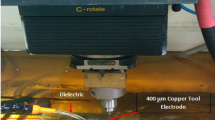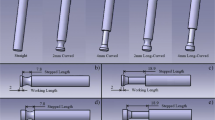Abstract
The aim of the present article is to fabricate pentagonal micro-cavities and describe the influence of current on the machining performances. Machining of EN-24 alloy steel samples was performed in die-sinking electrical discharge machining (EDM) machine with varying values of current using polygon cycle approach. The machined pentagonal cavities were examined under optical microscope and scanning electron microscope (SEM) to evaluate machining performances in terms of corner error, white layer formation, surface crack distribution, and globule formation. It is found that as the value of current increases, there is more formation of white layer with non-uniform distribution of cracks and the thickness of white layer increased from 6.21 to 8.20 µm with increase in current. On the other hands, surface finish deteriorates when the current value rises. In addition to this, there is an enhancement in tool wear rate with increasing current. At the higher values of current, the spark energy increases which leads to greater melting and evaporation and production of smoke and bubbles on the dielectric surface. This study revealed that die-sinking EDM coupled with short electronic pulses and precise electrode movement is capable of producing microstructures under appropriate operating conditions.








Similar content being viewed by others
References
Arooj S, Shah M, Sadiq S, Jaffery SHI, Khushnood S (2014) Effect of current in the EDM Machining Of Aluminum 6061 T6 and its effect on the surface morphology. Arab J Sci Eng 39(5):4187–4199. https://doi.org/10.1007/s13369-014-1020-z
Nikalje AM, Kumar A, Srinadh KVS (2013) Influence of parameters and optimization of EDM performance measures on MDN 300 steel using Taguchi method. Int J Adv Manuf Technol 69:41–49. https://doi.org/10.1007/s00170-013-5008-8
Guu YH, Hou M, Ti K (2007) Effect of machining parameters on surface textures in EDM of Fe–Mn–Al alloy. Mater Sci Eng A 466, 61–67. DOI: https://doi.org/10.1016/j.msea.2007.02.035
Liu K, Reynaerts D, Lauwers B (2009) Influence of the pulse shape on the EDM performance of Si3N4-TiN ceramic composite. CIRP Ann-Manuf Tech 58, 217–220. DOI: https://doi.org/10.1016/j.cirp.2009.03.002
Patel KM, Pandey PM, Rao PV (2009) Determination of an optimum parametric combination using surface roughness prediction model for EDM of Al2O3 /SiCw/TiC ceramic composite. Mater Manuf Processes 24:675–682. https://doi.org/10.1080/10426910902769319
Mahdieh MS, Mahdavinejad R (2016) Recast layer and micro-cracks in electrical discharge machining of ultra-fine-grained aluminum. Proc IMechE Part B: J Eng Manufact 1–10, DOI: https://doi.org/10.1177/0954405416641326.
Phan NH, Muthuramalingam T (2020) Multi-criteria decision-making of vibration-aided machining for high silicon-carbon tool steelwith Taguchi–topsis approach. SILICON. https://doi.org/10.1007/s12633-020-00632-w
Phan NH, Muthuramalingam T (2020) Multi criteria decision making of vibration assisted EDM process parameters on machining silicon steel using taguchi-DEAR methodology. SILICON. https://doi.org/10.1007/s12633-020-00573-4
Phan NH, Banh TL, Mashood KA, Tran DQ, Pham VD, Muthuramalingam T, Nguyen VD, Nguyen DT (2020) Application of TGRA-based optimisation for machinability of high-chromium tool steel in the EDM process. Arab J Sci Eng 45:5555–5562. https://doi.org/10.1007/s13369-020-04456-z
Amorim FL, Dalcin VA, Soares P, Mendes LA (2017) Surface modification of tool steel by electrical discharge machining with molybdenum powder mixed in dielectric fluid. Int J Adv Manuf Technol 91:341–350. https://doi.org/10.1007/s00170-016-9678-x
Sahu DR, Mandal A (2020) Critical analysis of surface integrity parameters and dimensional accuracy in powder-mixed EDM. Mater Manuf Processes 35:430–441. https://doi.org/10.1080/10426914.2020.1718695
Tang L, Du YT (2014) Experimental study on Green Electrical Discharge Machining in Tap Water of Ti–6Al–4 V and Parameters Optimization. Int J Adv Manuf Technol 70:469–475. https://doi.org/10.1007/s00170-013-5274-5
Khan AA, Ali MY, Haque MM (2009) A study of electrode shape configuration on the performance of die sinking EDM. Int J Mech Mater Eng 4:19–23
Lin Z, Guo Z, Jiang S, Liu G, Liu J (2018) Electrical discharge drilling of metal matrix composites with a hollow hexagonal electrode. Adv Compos Lett 27(5):193–203. https://doi.org/10.1177/096369351802700503
Nair S, Dutta A, Narayanan R, Giridharan A (2019) Investigation on EDM machining of Ti6Al4V with negative polarity brass electrode. Mater Manuf Processes 34:1824–1831. https://doi.org/10.1080/10426914.2019.1675891
Khan AA (2008) Electrode wear and material removal rate during EDM of aluminium and mild steel using copper and brass electrodes. Int J Adv Manuf Technol 39:482–487. https://doi.org/10.1007/s00170-007-1241-3
Gu L, Li L, Zhao W, Rajurkar KP (2012) Electrical discharge machining of Ti6Al4V with a bundled electrode. Int J Mach Tools Manuf 53:100–106. https://doi.org/10.1016/j.ijmachtools.2011.10.002
Singh NK, Pandey PM, Singh KK (2017) experimental investigations into the performance of EDM using argon gas assisted perforated electrodes. Mater Manuf Processes 32:940–951. https://doi.org/10.1080/10426914.2016.1221079
Yilmaz O, Okka MA (2010) Effect of single and multi-channel electrodes application on EDM fast hole drilling performance. Int J Adv Manuf Technol 51:185–194. https://doi.org/10.1007/s00170-010-2625-3
Ziada Y, Koshy P (2007) Rotating curvilinear tools for EDM of polygonal shapes with sharp corners. Annals of the CIRP 56:221–224. https://doi.org/10.1016/j.cirp.2007.05.052
Guodong L, Wataru N (2020) Realization of micro EDM drilling with high machining speed and accuracy by using mist deionized water jet, Precision Eng 61, 136–146, ISSN 0141–6359, https://doi.org/10.1016/j.precisioneng.2019.09.016.
Singh AK, Patowari PK, Chandrasekaran M (2020) Experimental study on drilling micro-hole through micro-EDM and optimization of multiple performance characteristics. J Braz Soc Mech Sci Eng 42:506. https://doi.org/10.1007/s40430-020-02595-w
Karthikeyan G, Garg AK, Ramkumar J, Dhamodaran S (2012) A Microscopic investigation of machining behaviour in l-ED-milling process. J Manuf Processes 14(3):297–306
Vidya S, Vijay V, Barman S, Chebolu A, Nagahanumaiah N (2015) Effects of different cavity geometries on machining performance in micro-electrical discharge milling. J Micro Nano Manufact3(1)
Das A, Tirkey N, Patel SK et al (2019) A comparison of machinability in hard turning of EN-24 alloy steel under mist cooled and dry cutting environments with a coated cermet tool. J Fail Anal and Preven 19:115–130. https://doi.org/10.1007/s11668-018-0574-6
Baldin V, Baldin CRB, Machado AR et al (2020) Machining of Inconel 718 with a defined geometry tool or by electrical discharge machining. J Braz Soc Mech Sci Eng 42:265. https://doi.org/10.1007/s40430-020-02358-7
Kuo CG, Hsu CY, Chen JH, Lee PW (2017) Discharge current effect on machining characteristics and mechanical properties of aluminum alloy 6061 workpiece produced by electric discharging machining process. Adv Mech Eng 9(11):1687814017730756
Belloufi A, Mezoudj M, Abdelkrim M et al (2020) Experimental and predictive study by multi-output fuzzy model of electrical discharge machining performances. Int J Adv Manuf Technol 109:2065–2093. https://doi.org/10.1007/s00170-020-05718-8
Straplets JL, Dimievi WL (2007) Textured surface for test sample card and mold for manufacturing the same, European Patent No. A2
Ekmekci B (2007) Residual stresses and white layer in electric dischargemachining (EDM). Appl Surf Sci 253, 9234–9240
Upadhyay C, Datta S, Masanta M et al (2017) An experimental investigation emphasizing surface characteristics of electro-discharge-machined Inconel 601. J Braz Soc Mech Sci Eng 39:3051–3066. https://doi.org/10.1007/s40430-016-0643-2
Ramasawmy H, Blunt L, Rajurkar KP (2005) Investigation of the relationship between the white layer thickness and 3D surface texture parameters in the die sinking. EDM Process Preci Eng 29(4), 479–490
Author information
Authors and Affiliations
Corresponding author
Additional information
Technical Editor: Lincoln Cardoso Brandao.
Publisher's Note
Springer Nature remains neutral with regard to jurisdictional claims in published maps and institutional affiliations.
Rights and permissions
About this article
Cite this article
Vidya, S., Wattal, R. & Rao, P.V. Investigation of machining performance in die-sinking electrical discharge machining of pentagonal micro-cavities using cylindrical electrode. J Braz. Soc. Mech. Sci. Eng. 43, 288 (2021). https://doi.org/10.1007/s40430-021-03012-6
Received:
Accepted:
Published:
DOI: https://doi.org/10.1007/s40430-021-03012-6




